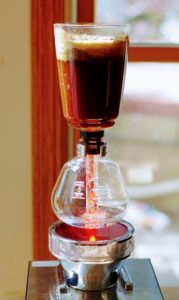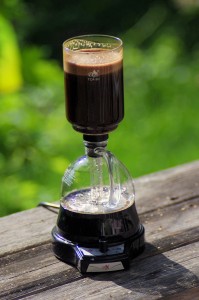Hario Syphon: Ultimate Brewing for the Enthusiast
I’ve waited forever to do this review. Why? I don’t know. Words fail me when discussing syphons, which used to be called vacuum makers, glass makers or sometimes percolators. You likely think I mean the dreaded pumping percolator, which became shortened to the single word designation, but I don’t. The two used to be distinguished from each other, but as the vacuum version got phased out, the pumping percolator got called a percolator. Since then, it’s been blamed for virtually taking the coffee industry down, but that’s another story… and blog post!
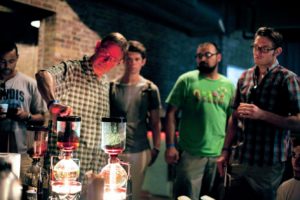
CoffeeCon Syphon class taught by long-time pal Charlie Sarin (thought not pictured). The Syphon is open-ended tech, with different presenters offering their individualized hacks and variations on the theme.
The Hario Syphon is one of two relatively popular and widely available syphon brewers. The other is made by Bodum and deserves its own review. Let’s take the Hario syphon and examine its strengths, and any potential weaknesses. It’s really not hard to understand a syphon. The lower bowl is really a kettle, where the water is heated in order to make coffee. The two bowls are fitted together. Once the water is heated to nearly a boil, hot air in the lower bowl expands, forcing the near-boiling water up through the upper bowl’s tube, through a filter where it starts bubbling as if it’s boiling – it’s not. At this point the barista (at home, you or me) adds finely ground coffee to the upper bowl and stirs it swiftly so it starts the extraction process. After roughly a minute, the siphon is removed from heat and the brewed coffee travels downward, as cooling air in the bowl below creates a vacuum (hence the original name) and drawing the coffee through the filter, where the spent grounds are trapped. When the coffee liquid is all down below, the two bowls are carefully detached (they’re hot!) and the lower bowl simply becomes a serving vessel.
At this point, lots of question should come to mind. For this reason, I’m inserting an FAQ here.
Syphon FAQ
- Does the syphon boil to make coffee? No, the water never boils. It remains at a near-ideal 200°F for the duration of the brewing contact time. The bubbles that appear are more expanding air being released as gas expands in the lower bowl. If just looks like it’s boiling.
- Why finer than drip grind? The siphon’s contact time between hot water and grounds is roughly two to three minutes, approximately half that of most drip brewers. You can grind finer, which reduces grounds surface area exposed to the hot water and the overall beverage strength will even out. Note: Automatic syphon brewers may take drip grind. Follow your maker’s recommendation.
- How did we get so lucky that the temperature in the upper bowl happens to be 200°F? We didn’t. Truth is, the standards that recommend 200°F brewing temperatures were developed by observing a siphon brewer and measuring its temperature. That temperature became the de facto ideal recommended extraction temperature for various brewing methods. Note, the syphon naturally brews at 200F, but if for some reason you want a lower or higher temperature, you’d best choose another method.
-
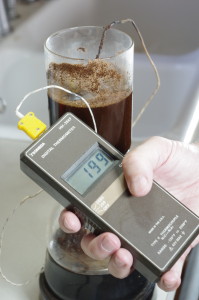
Competitor’s syphon compared. All syphons are reliable at achieving 200F brewing temperatures. Differences are durability, capacity and ease of use. Hario’s excels at all three.
Why wait until the water all goes to the top before adding the ground coffee? It’s the most reliable way to time the contact time, which must be done for consistent results. But, you don’t have to. There are several ways to use a siphon. I’m just giving you the one I’ve found works best in my experience.
- No matter how long I wait, all the water never really rises into the upper bowl. What am I doing wrong? Nothing. All the water will never rise into the bowl. Just understand, it doesn’t have to. All the water never needs to be in contact with the grounds. However, all of the grounds do need to be in contact with the water in the upper bowl.
- Is stirring necessary? Yes, I think so. I realize so-called automatic syphons don’t require nor recommend it. These designed used a developed force to propel the water up into the upper bowl and agitate the grounds, which were added before pressing the on button. This simplified method seemed to work, but I think the manual glass method used by Hario (and others) works best when the end user waits for the water to be mostly up in the upper bowl, adding the grounds and immediately stirring to make sure all the grounds are enrolled in the extraction process. The second stir is done because, on occasion, the grounds re-clump together during the minute or so after the initial stir. I realize I’m insisting upon being thorough here, but you may as well learn to do it right. It happens to me often enough that I think it’s worth sharing as a step.
How Did We Test the Hario?
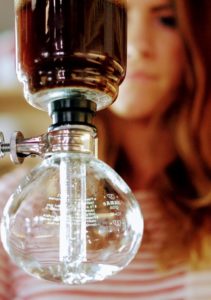
Note bubbling, boiling water in lower bowl during upper bowl brewing. This boiling water has no effect on brewing process, nor is it cause for concern that all the water never attends the extraction process. The syphon brewer is an excellent method.
I tested the Hario using it precisely as I described above. However, there are a few options for you to choose. The filter for instance. Hario supplies both a metal permanent filter and a cloth filter. As a long time syphon fan, to me there is no choice. I prefer cloth as the definitive filter of choice with this method. Metal is fine, but it does let some particulate through and into the final cup. While hardly objectionable and certainly never to the point of being described as sludge, I simply prefer the viscosity and taste of coffee filtered by cloth. To me it offers the ultimate coffee mouthfeel. While cloth filters are not permanent, they do last a month or more if carefully rinsed and stored. They take no more care than the metal permanent filter and they are renewable and inexpensive. I misplaced the one that came with the brewer and didn’t have the nerve to request more from Hario. I went online and purchased some from Amazon for around $5 shipped Prime. About a year’s supply for me. I can’t complain.
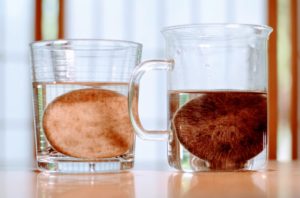
On the left is a fresh cloth filter, after its first use. Right is a two-week-old filter. Notice discoloration begins immediately and darkens with each use, regardless of scrubbing. Works fine regardless. I suggest not worrying about discoloration which seems to have little effect on cup taste.
Don’t be a Purist. The benefits of pre-heating water
One thing I recommend. Don’t pour cold water directly into the syphon for heating. Boil it in a separate kettle. It saves time and energy. I just used a nearby BonaVita kettle but any one will do. I set it to 203°, my normal drip set temperature and used its gooseneck to carefully pour the near-boiling water into the lower syphon bowl. Then I placed the syphon bowl on a heat source. I guess I qualify as a barista because Hario supplied me with an infrared beam heater. I do not know if these heaters are available to the public, but if they are, I highly suggest one if you are committed to syphon long-term. They are simply so easy to use. They also illuminate the process beautifully. Admit it. Part of the syphon’s allure is its theatrical visual as it does its stuff. The beam heater captures all this in its glory.
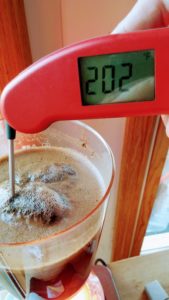
Looks like it’s boiling, but it’s not. The upper bowl, where extraction takes place, is typically within a few degrees of 200F. Many consider this ideal contact temperature.
Beam Heaters versus Flame
A check online of beam heaters tells me it’s at this writing a $250 option. Meanwhile a flame lamp is easy and inexpensive at around $30. Frankly, some baristas tell me they think it’s the ideal way to brew with the syphon. More responsive and direct heat using the flame. If you preheat it, it takes very little time. If you don’t, the beam heater is still too slow. Visually, the lamp gives very little to the beam heater. Both make great coffee. Your call.
Is the Syphon Hard to Use?
The Syphon is not hard to use. It does take some effort and attention, but it’s not hard. The method is actually very reliable and, assuming you agree with the industry’s standards, the syphon follows them perfectly. As I said, it was the model for those standards.
Here are a few potential cons to syphon brewing.
- Thorough cleaning. Not dishwasher safe. As far as I know you cannot just pop the Hario syphon parts into our dishwasher. They require hand washing. You need to thoroughly rinse and perhaps use a little mild or unscented detergent to clean a syphon before putting it away after using. It’s not difficult. The Hario syphon is substantial. It is far better made tempered glass than most others I’ve tried over the years. Still, while hot all syphons are more fragile than cold.
- Syphons get hot. I just finished teaching a syphon class at CoffeeCon NY in Brooklyn. There were two small children in the first row. I wasn’t worried at all, but know that I would always use care when brewing in a home with children. The parts get hot, near-boiling water if traveling up and down in the unit. The beam heater or lamp both get even hotter to do their job. It’s not a unit to ever leave unattended. However, I also made stovetop French fries the other evening when my family was over, and all the same risks remain. Same cautions.
- A cloth filter takes an extra step. It must be thoroughly rinsed and a drop of detergent may be helpful as well to keep it free from oil buildup. It never looks clean after initial staining, but practical use has shown me this means little and doesn’t in my opinion compromise its effectiveness in the coffee making process.
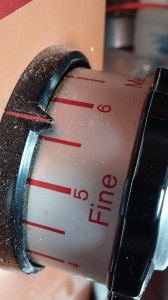
Grind fineness depends upon contact time. The Hario typically takes a grind finer than drip coupled with a 3 minute contact time.
Conclusion
Do you need a syphon? Of course not. The question is akin to asking, “Do I really need an iPad? There’s virtually nothing you can do on an iPad you can’t accomplish on a laptop or other mobile device. The point is it’s ideal for some situations and uses. Same with a Syphon. I know of no better, more thorough and reliable extractor of coffee oils than the Syphon. It never needs to be de-limed with citric acid. Its filtration contains little or no plastic that can become smelly with time and use. The syphon is the best method of extracting from all the grounds. No matter how thoroughly you use drip, most drip cone designs contain some “trouble zones” where grounds in those areas are likely to be less extracted. The syphon’s natural bubbling acts as an extraction facilitator, using what Bunn Corporation calls “turbulence” throughout the contact time. The very dry spent grounds observed after the finished coffee beverage has been drawn down below is evidence of the effectiveness of the final separation of brew from grounds of the syphon.
I can’t imagine being a coffee enthusiast without owning a syphon. And, Hario makes one of the best; perhaps the best.
Podcast: Play in new window | Download

